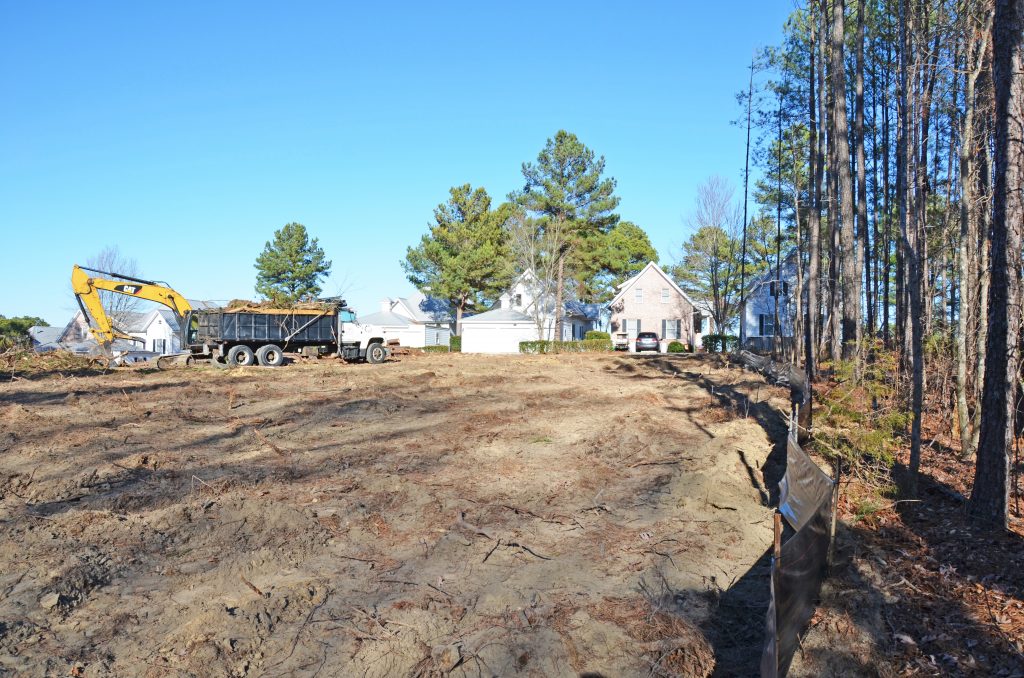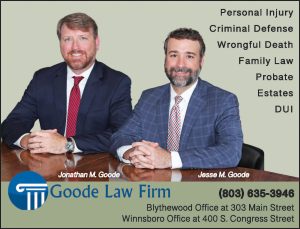
This photo was taken on Jan. 14, 2018, shows a clear cut in progress on five contiguous wooded lots between Links Crossing Drive and Golden Spur Lane in Cobblestone Park. | Michael Criss
BLYTHEWOOD – During its February meeting, Town Council voted to adopt an amendment to the town’s tree preservation ordinance that would remove an exemption that Town Attorney Jim Meggs suggested is being interpreted by developers as permission to clear cut lots without a tree removal permit from town hall.
On Monday night, the Planning Commission saw things from the developers’ perspective and unanimously recommended that Council reverse its decision and vote against adopting Meggs’ amendment when it takes a second and final vote on the issue at its April meeting.
For years, Blythewood’s town administrator, with input from the town attorney, planning consultant and planning commission, has been interpreting the town’s tree preservation code to mean the town government can enforce tree removal permits on undeveloped, platted, single-family residential lots in established subdivisions or new neighborhoods like Abney Hill Estates, Phase 2.
But when Michael Criss, the town’s planning consultant, recently tried to stop developer D.R. Horton from clear cutting five lots in Cobblestone Park next to the mayor’s home, the town’s attorney, Jim Meggs, examined the town’s tree preservation ordinance more closely and decided the ordinance contained a weakness that allowed another interpretation of the ordinance, one that developers were using to clear cut lots without a permit from town hall.
That weakness, Michael Criss told the Planning Commission on Monday evening, is found in section (H) of the ordinance and states that, those projects are exempt from the permitting process for tree removal if they have received major subdivision or site plan approval prior to the effective date of this subchapter and amended major subdivision and site plans.
“If Mr. Meggs’ interpretation of the current code is correct and would prevail,” Criss told the Commissioners, “the town’s hands are tied in enforcing permits for tree removal on undeveloped lots in most of our neighborhoods in the town – Ashley Oaks, Abney Hill Estates, Cobblestone Park, Blythe Creek, Lake Ashley, etc.”
To remedy what Council termed a loophole in the ordinance, Meggs’ drafted amendment surgically removes exemption (H) from the ordinance.
Jesse Bray, representing D. R. Horton, pushed back against that amendment.
“We’ve cleared [clear cut] dozens of acres in Cobblestone and it wasn’t an issue, but now it seems to be an issue because it’s next to the mayor’s house,” Bray told the Commissioners. “You throw around ‘flaw’ and ‘loophole’. It’s not a loophole. It’s in your ordinance. D. R. Horton is not trying to get away with anything. We’re the largest builder in the U. S. We don’t skirt rules,” Bray said.
“Look at the plot plans…we have a 60-foot x 120-lot, the average lot size in Cobblestone. It has a 15-foot setback, a five-foot side set back and we’re allowed to clear a 20-foot buffer around the 50-foot x 50-foot home site. That leaves you ten feet in back. If we have a swale for drainage, that comes out of the ten feet,” Bray told the Commissioners.
Complicating the issue is that the current tree preservation ordinance, which was adopted in 2015 with the intent of preserving trees, would have done just that had the General Assembly not interfered.
“In its wisdom, the General Assembly voted in 2010 and again in 2013 to protect developers hard hit by the 2008 recession by extending the life of the existing local development permits for nine years,” Criss said. “That kept permits alive that dated as far back as 2007. Since then, Blythewood has adopted stricter tree preservation regulation and stricter storm water management regulations. But just about all of the town’s projects now fall under the General Assembly’s grandfathered rules,” Criss said. While the grandfathered rules continue projects previously permitted for roads and infrastructure, they can also thwart the town’s current ordinance by enabling previously permitted mass-graded projects to remove all trees from individual lots as well as roadways, storm drainage areas, etc.
“Under the current ordinance, we felt the individual lots were protected from clear cutting in Cobblestone Park,” Criss said. “The town attorney felt there was a weakness in the ordinance and he is trying to fix it with this proposed text amendment.”
Town Council is expected to take its second and final vote at the April meeting.












The only “grandfathered” permits this effects are active permits – like those D.R. Horton is operating under in Cobblestone Park. All others referenced in Mr. Criss’ comments probably have expired throughout the Town and would be subject to the current ordinances should the landowners reapply. The impression being forwarded is that there are dozens of subdivisions that would be allowed to clear cut their lots if section (H) is not repealed. This is factually untrue. Any new permits for home construction or development – even those in Cobblestone Park – will require the tree preservation ordinances to be followed.
What this repeal would actually do is establish a precedent that permits that have been justly granted can be changed at the whim of the Town with no consideration given to the vested rights of property owners, whether individuals or developers . That is the crux of the opposition as allowing this to happen unchallenged tramples upon protected rights under State law.